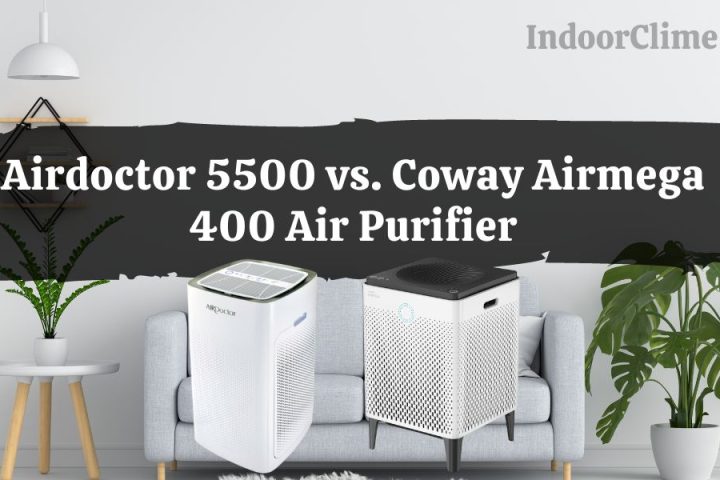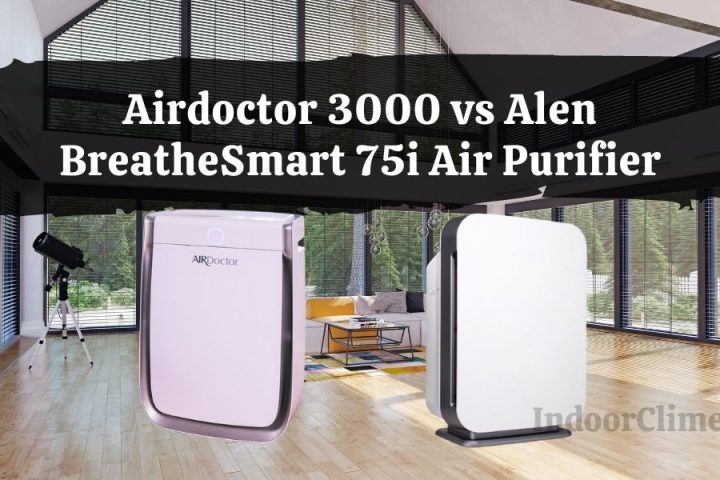Air purifiers are simple but necessary machines in our homes to help us eliminate airborne allergens such as pollen, mold spores, pet dander, bacteria, viruses, smoke, and odors.
We have tested dozens of air purifiers, and here are top-notch performers that are also affordable and good-looking.
 |
AirDoctor 3500i
Best Overall |
CHECK PRICE |
 |
Medify MA-112
Runner Up |
CHECK PRICE |
 |
Blueair DustMagnet 5410i
Best For Smoke |
CHECK PRICE |
 |
Alen BreatheSmart 75i
Best for Pets
|
CHECK PRICE |
 |
AirDoctor 5500i
Best For Large Rooms |
CHECK PRICE |
 |
Blue Pure 311i Max
Best For Bedroom |
CHECK PRICE |
Best Overall
Airdoctor 3500i Air Purifier
AirDoctor 3500i air purifier stands out with 630 square feet of room coverage 4 times an hour and can catch 99.99% of airborne particles as small as 0.003 microns.
With a CADR rating of 340 CFM, it is one of the most powerful air purifiers.
It has everything you may need from an air purifier – it looks good, it doesn’t take up much space. It is super easy to maintain and use.
It has all the features you may need – a timer, auto mode, filter change indicator, dim function for nighttime, and an app with real-time data. Check your home’s current or historic air quality right from your phone.
Pros
Cons
Runner Up
Medify MA-112 Air Purifier
This massive air purifier can handle 1,045 sq. ft. 4x per hour, catching up to 0.1 microns of small particles. Its CADR rating is 560, one of the highest of any air purifier.
Medify MA-112 contains massive filters, and it filters almost everything fast, thanks to its powerful fan.
It also looks good, and you can choose between black and white.
The downside is the large size, and it is a bit expensive.
Pros
Cons
Best For Smoke
Blueair DustMagnet 5410i Air Purifier
Not as powerful as the first 2 air purifiers in our list, BlueAir DustMagnet 5410i can cover 360 square feet in a large room 4x an hour.
This BlueAir model has won various prizes thanks to its design. It is really elegant and stylish.
BlueAir DustMagnet 5410i is super quiet, even at high speed. And in night mode, you can barely hear it.
Thanks to its particle and carbon combo filter, it’s one of the best for smoke.
This air purifier also has rich features and an app control with live air quality data and more.
Pros
Cons
Best for Pets
Alen BreatheSmart 75i Air Purifier
Alen Breathesmart covers a 650-square-foot large room, filtering air 4x every hour. It performs greatly even in very dirty air.
It is quiet and user-friendly and is equipped with an app control. Like AirDoctor, it also has color rings showing air quality in the room.
One of Alen’s pros is that you may choose between many colors. You have a wide choice of front cover designs.
Yet it has many features, is powerful, and is great at filtering airborne particles; its downside is its high price and large size.
Pros
Cons
Best For Large Rooms
AirDoctor 5500i Air Purifier
AirDoctor 5500i can cover massive 1,085 square feet large spaces with a 4x per hour air exchange rate. It has 6 filters and air intake from both sides.
It can trap 100 smaller particles than any traditional HEPA filter air purifier. It is powerful and helps eliminate all airborne particles, including tiny viruses.
It has smart features, auto mode, and an app with many functions, including passing controls over to your friend’s phone.
This could easily be the number one air purifier in the world, but it’s not the most affordable and quite large. But you won’t find a better machine for large spaces than this AirDoctor 5500i model.
Pros
Cons
Best For Bedroom
Blueair Blue Pure 311i Max Air Purifier
You may think you need a tiny air purifier for your bedroom, but that’s not true. The smallest ones can’t clean the air well enough. So here is the best option for your bedroom – BlueAir Blue Pure 311i Max.
It handles 387 square feet of space, cleaning them 4x every hour. And thanks to washable pre-filters, the life of primary filters is longer. Which means you save money.
The exterior of the air purifier is pre-filter, and BlueAir offers 5 different color options.
It is best for bedrooms thanks to its quiet performance and adjustable brightness.
This air purifier is also smart; it has an app with many options, including LED light brightness control.
Pros
Cons
Things to Consider Before Buying Air Purifiers
There are many things to consider before buying an air purifier, but the most important is the room size, which needs to be cleaned. Then comes filters and what they can catch, features, noise, energy consumption, design, and price.

Room Size
Room size is crucial when purchasing an air purifier because the device’s effectiveness depends on its ability to circulate and clean the air within a specific space.
Air purifiers are designed to clean a certain volume of air per unit of time, usually measured in cubic feet per minute (CFM) or square feet. If the air purifier is too small for the room, it may not be able to adequately clean the air, leading to decreased efficiency and potential health concerns.
Another important factor many people don’t consider is the Air Exchange Rate or how many times air purifiers can move whole air in a specific size space.
Many air purifier manufacturers show their coverage area but don’t mention that it’s with 1, 2, or 5 air exchange rates. That’s a huge difference in whether the air in a 300-square-foot room can be cleaned 1x or 5x.
So we recommend determining how large the room you need to clean. Then, pick an air purifier that can handle such an area with an Air exchange rate of at least 4. If your room is 300 square feet, you need an air purifier with a coverage area of 300 sq. ft 4x/hour.
If the manufacturer doesn’t show the Air exchange rate, you can compare the CADR rating with other manufacturers and see how large coverage areas they show.
Also, remember that the coverage area is shown for standard ceiling height, which is 8ft. If you have higher ceilings, you need a larger coverage area air purifier.
Filters

Another super important factor – filters. Without filters or with bad filters, air purifiers are useless. And remember not always, but most of the time, the larger the filters, the better they are to trap contaminants.
Especially carbon filters. They can’t filter odors and smoke well enough if they are not thick and large enough.
Most of the air purifiers use HEPA filters. A HEPA filter, or High-Efficiency Particulate Air filter, is a mechanical air filter designed to capture particles of very small size, including microscopic particles and allergens.
HEPA filters are designed to capture particles as small as 0.3 micrometers with high efficiency. Most HEPA air purifiers can capture 99.97% of particles that size.
Most particles are that size or larger; for example, HEPA filters easily catch pollen and mold spores.
But there are air purifiers with even more advanced filters. For example, AirDoctor uses its own patented UltraHEPA filters that can trap 100 smaller particles up to 0.003 microns in size. Such small particles are mostly viruses and bacteria.
HEPA filters can’t trap VOCs (chemicals released by paint, plastics, cleaning products, etc) and odors and smoke. If you want to filter these particles, aim for a carbon/VOC filter. Most of the best air purifiers have them.
Features
Technically, you can live without features, but if an air purifier has them, that’s even better. Few are very important, though.
For example, auto mode and built-in particle sensors are a must. That way, the air purifier reads your air pollution and adjusts the fan speed for proper filtration. With these features, you save money because the air purifier will work at a lower fan speed as soon as the air becomes cleaner, so it consumes less electricity.
You may want to have a child lock feature if you have children.
If you use an air purifier in your bedroom, dim lights or night mode should be a feature to look for.
Filter change indicator is a must, and most air purifiers have it.
The remote control is great, but the app is even better. That way, you can turn your device on and off even when you are not home.
Other features, such as handles or casters for larger devices, are also things you need to consider.
Noise

As we use air purifiers 24/7, or at least you should, noise level is very important. You don’t want loud wind noise all day long.
Large spaces air cleaners are louder because they move more air, but they can become quiet when used at lower fan speeds.
Most air purifiers have several fan speeds, so you can switch to lower when necessary to make it quiet.
Most air purifiers are in the 30-50dB range, so they are similar.
Energy Consumption
As mentioned before, we use air purifiers constantly. So they consume energy all the time. The less they consume, the less money they spend.
So take into note checking wattage before buying an air purifier as well.
Design
This is very subjective, but you can’t hide your air purifier; otherwise, it won’t be effective. So most of the time you will see it. So don’t buy ugly machines.
There are many attractive air purifiers out there, and most of them are okay.
Another design aspect is where air intake, outlet, and controls are. How is the air purifier built? Is it easy to change filters, etc.? You should consider these things as well.
Price
A good air purifier is not the cheapest one and also not the most expensive one. Most of the best air purifiers are affordable.
Remember that all air purifiers require filter change at least 1-2 times a year, so check if replacement filters are available and how expensive they are.
Don’t fall for cheap filters, as they are probably not good either.







